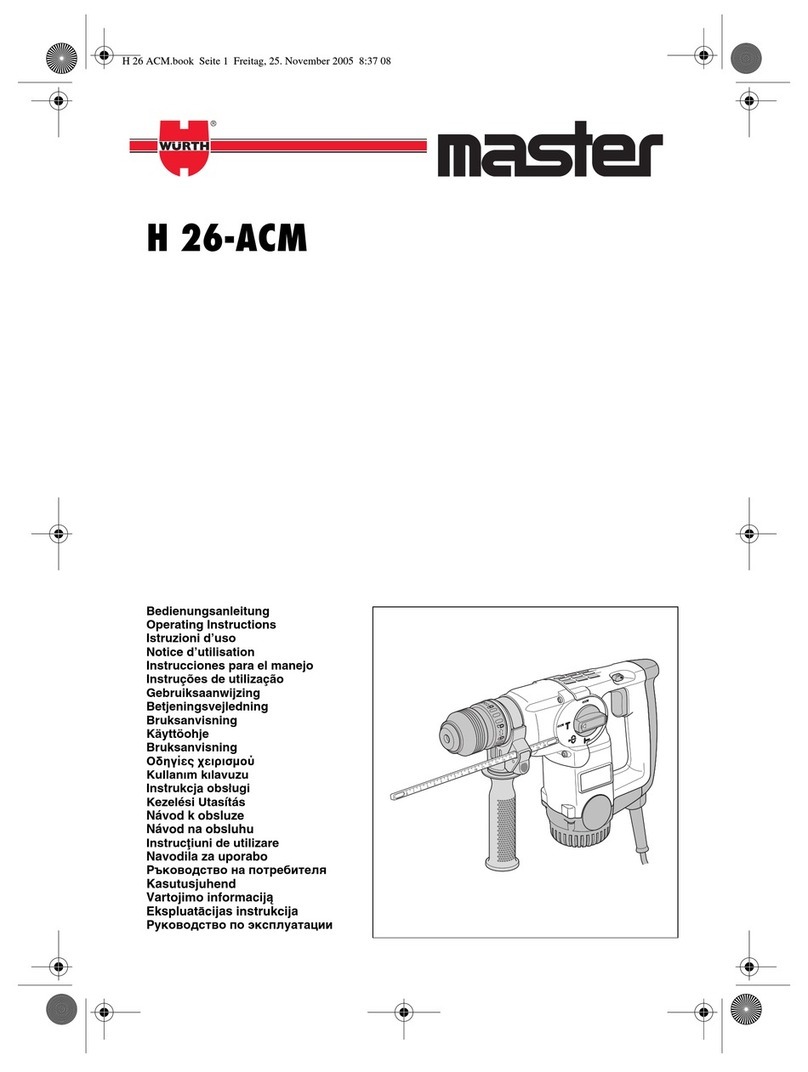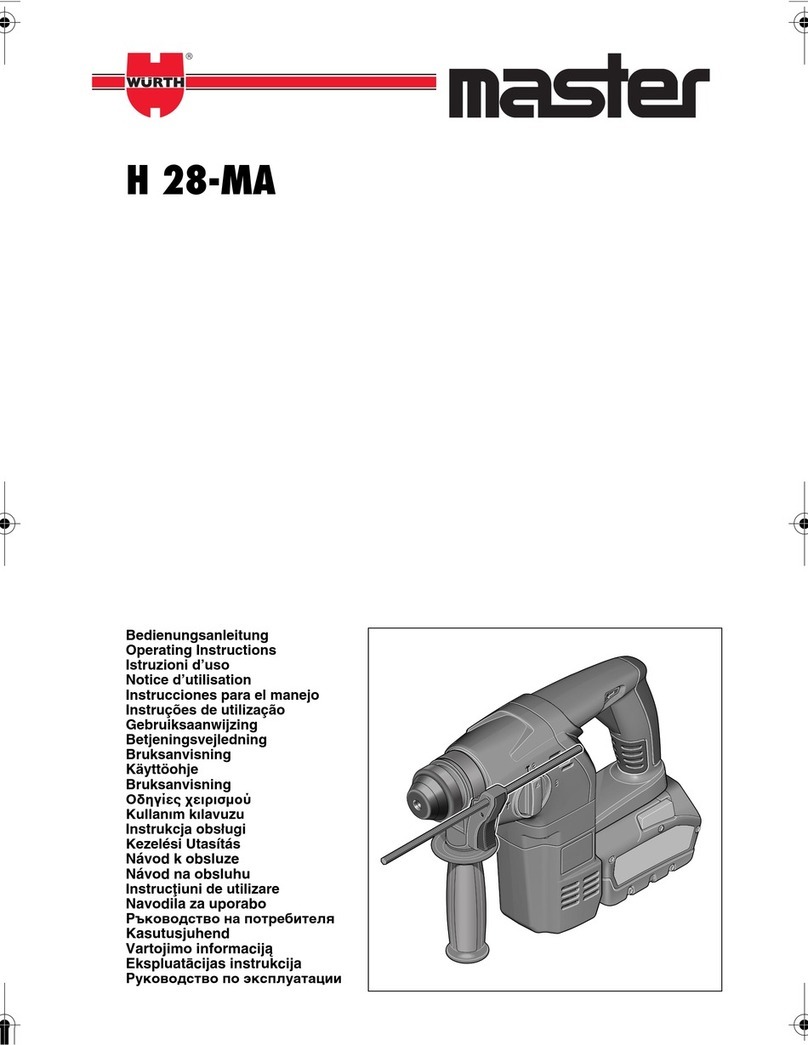4
Entfernen Sie Einstellwerkzeuge oder Schrau-
benschlüssel, bevor Sie das Elektrowerkzeug
einschalten. Ein Werkzeug oder Schlüssel, der sich in
einem drehenden Geräteteil befindet, kann zu Verletzun-
gen führen.
Vermeiden Sie eine abnormale Körperhal-
tung. Sorgen Sie für einen sicheren Stand und
halten Sie jederzeit das Gleichgewicht. Dadurch
können Sie das Elektrowerkzeug in unerwarteten Situatio-
nen besser kontrollieren.
Tragen Sie geeignete Kleidung. Tragen Sie
keine weite Kleidung oder Schmuck. Halten
Sie Haare, Kleidung und Handschuhe fern von
sich bewegenden Teilen. Lockere Kleidung,
Schmuck oder lange Haare können von sich bewegenden
Teilen erfasst werden.
Wenn Staubabsaug- und -auffangein-
richtungen montiert werden können,
vergewissern Sie sich, dass diese angeschlos-
sen sind und richtig verwendet werden. Verwen-
dung einer Staubabsaugung kann Gefährdungen durch
Staub verringern.
Verwendung und Behandlung des Elektrowerk-
zeuges
Überlasten Sie das Gerät nicht. Verwenden Sie
für Ihre Arbeit das dafür bestimmte Elektro-
werkzeug. Mit dem passenden Elektrowerkzeug arbei-
ten Sie besser und sicherer im angegebenen
Leistungsbereich.
Benutzen Sie kein Elektrowerkzeug, dessen
Schalter defekt ist. Ein Elektrowerkzeug, das sich
nicht mehr ein- oder ausschalten lässt, ist gefährlich und
muss repariert werden.
Ziehen Sie den Stecker aus der Steckdose
und/oder entfernen Sie den Akku, bevor Sie
Geräteeinstellungen vornehmen, Zubehör-
teile wechseln oder das Gerät weglegen. Diese
Vorsichtsmaßnahme verhindert den unbeabsichtigten
Start des Elektrowerkzeuges.
Bewahren Sie unbenutzte Elektrowerkzeuge
außerhalb der Reichweite von Kindern auf.
Lassen Sie Personen das Gerät nicht benutzen,
die mit diesem nicht vertraut sind oder diese
Anweisungen nicht gelesen haben. Elektrowerk-
zeuge sind gefährlich, wenn sie von unerfahrenen Perso-
nen benutzt werden.
Pflegen Sie Elektrowerkzeuge mit Sorgfalt.
Kontrollieren Sie, ob bewegliche Teile ein-
wandfrei funktionieren und nicht klemmen, ob
Teile gebrochen oder so beschädigt sind, dass
die Funktion des Elektrowerkzeuges beein-
trächtigt ist. Lassen Sie beschädigte Teile vor
dem Einsatz des Gerätes reparieren. Viele
Unfälle haben ihre Ursache in schlecht gewarteten Elekt-
rowerkzeugen.
Halten Sie Schneidwerkzeuge scharf und sau-
ber. Sorgfältig gepflegte Schneidwerkzeuge mit schar-
fen Schneidkanten verklemmen sich weniger und sind
leichter zu führen.
Verwenden Sie Elektrowerkzeug, Zubehör,
Einsatzwerkzeuge usw. entsprechend diesen
Anweisungen. Berücksichtigen Sie dabei die
Arbeitsbedingungen und die auszuführende
Tätigkeit. Der Gebrauch von Elektrowerkzeugen für
andere als die vorgesehenen Anwendungen kann zu
gefährlichen Situationen führen.
Service
Lassen Sie Ihr Elektrowerkzeug nur von quali-
fiziertem Fachpersonal und nur mit Original-
Ersatzteilen reparieren. Damit wird sichergestellt,
dass die Sicherheit des Elektrowerkzeuges erhalten bleibt.
Sicherheitshinweise für Hämmer
Tragen Sie Gehörschutz. Die Einwirkung von Lärm
kann Gehörverlust bewirken.
Benutzen Sie Zusatzgriffe, wenn diese mit dem
Elektrowerkzeug mitgeliefert werden. Der Ver-
lust der Kontrolle kann zu Verletzungen führen.
Halten Sie das Gerät an den isolierten Griffflä-
chen, wenn Sie Arbeiten ausführen, bei denen
das Einsatzwerkzeug oder die Schraube ver-
borgene Stromleitungen treffen kann. Der Kon-
takt mit einer spannungsführenden Leitung kann auch
metallene Geräteteile unter Spannung setzen und zu
einem elektrischen Schlag führen.
Weitere Sicherheits- und
Arbeitshinweise
Beachten Sie die Netzspannung! Die Span-
nung der Stromquelle muss mit den Angaben
auf dem Typenschild des Elektrowerkzeuges
übereinstimmen. Mit 230 V gekennzeichnete
Elektrowerkzeuge können auch an 220 V
betrieben werden.































